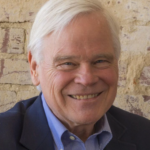“The Savage South” is an image that retired UNC-Chapel Hill Lineberger Professor of the Humanities at Fred Hobson thinks and writes about. He tried to explain to me why, over the years from colonial times until today, so many observers characterize our region as being more violent, more savage, than other parts of the United States.
People have given many reasons to explain our region’s image. Of course, the institution of slavery is often at the top of the list.
But Hobson asserts that, even before slavery had taken deep root, the southern colonies had a bad reputation. According to Hobson, the weather played some role. It was hot and miserable in the South during the summer—contributing to bad temper and misery. On the other hand, says Hobson, the warm weather made it easier to get subsistence crops out of the ground, so that some farmers had too much free time, leading to sloth and sometimes violence.
Still slavery and its accompanying brutality were major reasons for the South’s bad reputation until the Civil War put an end to it. But the backwoods, mountain, and other “frontier” areas of the South never had a significant slave presence or culture. Nevertheless, observers viewed these areas as part of the “Savage South.”
Hobson got my attention when he explained that these areas were settled mostly by hard-headed, independent-minded people from Northern Ireland, who were accustomed to standing up to authority and fighting to get whatever they considered to be rightfully theirs.
Now, he was talking about my people, “Scots-Irish.” They were hardline Presbyterian Scots whose families had been settled in Ireland for many years. They had to fight for their rights in Ireland, both against the mostly Catholic native Irish, whom their settlements often displaced, and their English overlords, who tried to force the Anglican Church on them.
The title of former Senator and Navy Secretary James Webb’s book, “Born Fighting,” support supports Hobson’s assertion that these Scots-Irish were a major factor in the “Savage South” image.
The Romans conquered the southern part of Britain but never controlled what is now Scotland. In fact, the Romans built a wall across the island to keep the northerners from attacking them—Hadrian’s Wall.
There followed centuries of border wars between the ancestors of the Scots-Irish and the people who lived to their south. After the Norman conquests, the Scots resisted the Norman feudal model and their kings’ attempts to impose it on Scotland.
In about 1603, the Scottish King James VI became King James I of England. Shortly afterwards, in an effort to gain greater control of Ireland, thousands of Presbyterian Scots moved to the northern part of Ireland to take over lands confiscated from native Irish Catholics.
After years of standing up to and fighting both the Irish and the English overlords, waves of these Ulster Scots began migrating to the colonies, many of them winding up on the frontiers and in the mountains, with a great presence in the South. In America they fought Indians on the frontier and stood up to the English colonists who ran the colonial governments. When the American Revolution broke out, the Scots-Irish provided more than 40 percent of the troops that fought the British.
Webb asserts that the Scots and the Scots-Irish, throughout their history, tended to select their leaders, rather than merely blindly following those who were put in charge. Their leaders had to earn their respect and loyalty. It was not automatic. And they expected their leaders to be brave, assertive, and tenacious.
These traits made the Scots-Irish the backbone of American fighting forces in the Revolution, Civil War, both World Wars, Korea, and Vietnam, where Webb himself fought bravely. They are the fighting traits, though, that also helped give rise to the “Savage South” image that Hobson discusses.
However, Webb believes that the fighting qualities of the Scots-Irish are basically positive values in themselves. Webb’s sub-title for “Born Fighting” is “How the Scots-Irish Shaped America.” I do not know how Webb would react to an idea that associated the Scots-Irish with an image of the “Savage South.” But there is no doubt that he would assert that the Scots-Irish traits of independence, suspicion of authority, and resistance to oppressive government are important and healthy characteristics that undergird the American democratic experience.
Whatever you think of the Scots-Irish and their various traits, one thing is quite clear. America would not be the same without them (or should I say, without us.)
D.G. Martin, a lawyer, retired as UNC system vice president for public affairs in 1997. He hosted PBC-NC’s “North Carolina Bookwatch,” for more than 20 years.
Chapelboro.com does not charge subscription fees, and you can directly support our efforts in local journalism here. Want more of what you see on Chapelboro? Let us bring free local news and community information to you by signing up for our newsletter.
One on One: The ‘Scots-Irish’ and the ‘Savage South’ Chapelboro.com.
Read More Details
Finally We wish PressBee provided you with enough information of ( One on One: The ‘Scots-Irish’ and the ‘Savage South’ )
Also on site :
- Broncos sign TE Caden Prieskorn after injury hits the position
- I Tried 8 Store-Bought Mayos and the Winner Was Abundantly Clear
- '90s Heartthrob Shows Off Hidden Talent—and Fans Are Obsessed

